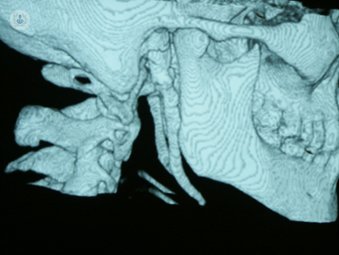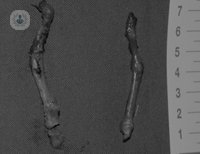Eagle syndrome, knows about this rare disease
Written by:Anna, a patient with Eagle syndrome, visited several specialists without knowing what was wrong, until he was diagnosed and had surgery to return to being a "healthy and happy" person.
 Sometimes they come to the consultation of otolaryngology anxious patients having passed through countless specialists, disheartened after suffering failures diagnostics, poly medicated with analgesic, anti-inflammatory and often, antidepressants, and labeled as psychosomatic disorder patient.
Sometimes they come to the consultation of otolaryngology anxious patients having passed through countless specialists, disheartened after suffering failures diagnostics, poly medicated with analgesic, anti-inflammatory and often, antidepressants, and labeled as psychosomatic disorder patient.
There are complaints that, by its rarity, may be unknown even to the doctor. Or, you can discard that, when he has to make a diagnosis in unusual and varying symptoms. If you have not had previous experience, Eagle syndrome is difficult to recognize.
What's Syndrome Eagle?
All people possess a bone on each side of the base of the skull-shaped tusk, up to each ear to about 4 or 5 cm deep. Styloid process and are called by the style-hyoid ligament, connecting the skull to the hyoid bone in the neck. When one or both ligaments ossify or calcify, giving rise to the Eagle syndrome. It is a very rare disorder.
Eagle syndrome, symptoms
The diagnosis of a patient with Eagle's Syndrome is based on the presence of a number of symptoms that, after the usual examinations are not allowed explanation is. Patients have a variable number of painful sensations in the throat defined as intense and varied journey puncture location.
In addition, they may have ear pain, feeling hearing "capped" excessive production of saliva, difficulty speaking or swallowing, limitation of neck movements, noise level of the temporomandibular joint, sensation of a foreign body in the back of the mouth, forcing the patient to swallow frequently, dizziness and even temporary loss of consciousness.
Sometimes it can be felt in the mouth abnormal ossification. Suspecting Eagle syndrome, X-rays and CT specific practice.
Eagle syndrome, surgery
 The only treatment for Eagle syndrome is surgery. Includes the removal of the ligament is ossified, and can be done in two ways:
The only treatment for Eagle syndrome is surgery. Includes the removal of the ligament is ossified, and can be done in two ways:
- Through the mouth to enter the elongated styloid process and obtain its removal.
- External or cervical. It comes to this technique when the ossification reaches the hyoid bone ossification-full of all the ligament,
Eagle syndrome, a real case
Anna, a patient, explains:
"I had just had a son. For over three years I was wandering through countless specialists who gave me a lot of medication. I was very nervous and over with a baby. There were many depressing views. And I learned that you had never tell the doctor about your mood because you served them on a platter the diagnosis of depression or anxiety. "
"It is very frustrating to see that no one understands you and think that you might have to follow the rest of your life with this excruciating pain. I ended up thinking I had lymphoma. And it was not until I was diagnosed with the syndrome and I had surgery I could go back to being the person he had been before. Healthy and cheerful "
Anna was Eagle's Syndrome. Therefore, doctors must be very cautious before putting a patient label psychosomatic disorder. We should strive to convince the person in front. Many people do not know where to turn, and is looking forward to be the person who has always been: a healthy and cheerful person.



